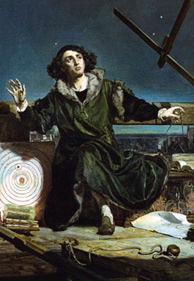| Cultural juggernauts: Nicolaus Copernicus, 1473-1543 |
|
Nicolaus Copernicus was destined to become, through the publication in 1543 of his heliocentric theory, De Revolutionibus Orbium Coelestium1, one of the seminal figures in the history of scientific thought.
Dissatisfied with the complexity and improbability he found in the then standard Ptolemaic model, where all planets including the sun rounded an immobile Earth, Copernicus, in lieu asserted a new2 mechanical description whereby the earth rotated on its axis once daily and rounded the sun on its trajectory once yearly, a sensational concept for the times.
In so doing, Copernicus not only advanced a major contribution to Western natural philosophy, he also exerted a great affect on the human spirit. Waiving the tremendous privilege of being in the center of the universe, Copernicus opted for a system viewed long after his death by the ecclesiastical community as un-divine, relegated, and only important in peripheral terms to the rest of space.
In a famous quote, Copernicus supposed3 that he "zatrzymał słonce, i poruszył ziemie," or stopped the sun, and moved the earth," an indication of the importance of a theory later responsible for a paradigm shift.
|

|
An autodidactic, Copernicus also studied Greek, mathematics, geography, the works of Plato, and theology. One can visit his birthplace in Toruń or his main residence at the Frombork Cathedral where he assumed a canonship for most of his life.
Wikipedia biography
1 On the Revolutions of Heavenly Spheres”
2 Aristarchus of Samos, 310 BC - ca. 230 BC, proposed the heliocentric theory sixteen centuries before Copernicus.
3 Likely a fable as Copernicus kept his scientific pursuits completely to himself out of public view. Fearing retribution a friend published his theory only after his death in 1543.
|
|
|
